Interpreting Soft-Sediment Deformation Structures: Insights into Earthquake History and Depositional Processes in the Dead Sea, Jordan
Abstract
:1. Introduction
2. Geological and Tectonic Setting of The Study Area
3. Materials and Methods
3.1. Sedimentary Sections
3.2. Experimental Methods
4. Results and Interpretations
4.1. SSDSs in the DSB
4.1.1. Small-Scale Slumps
4.1.2. Mixed Layer
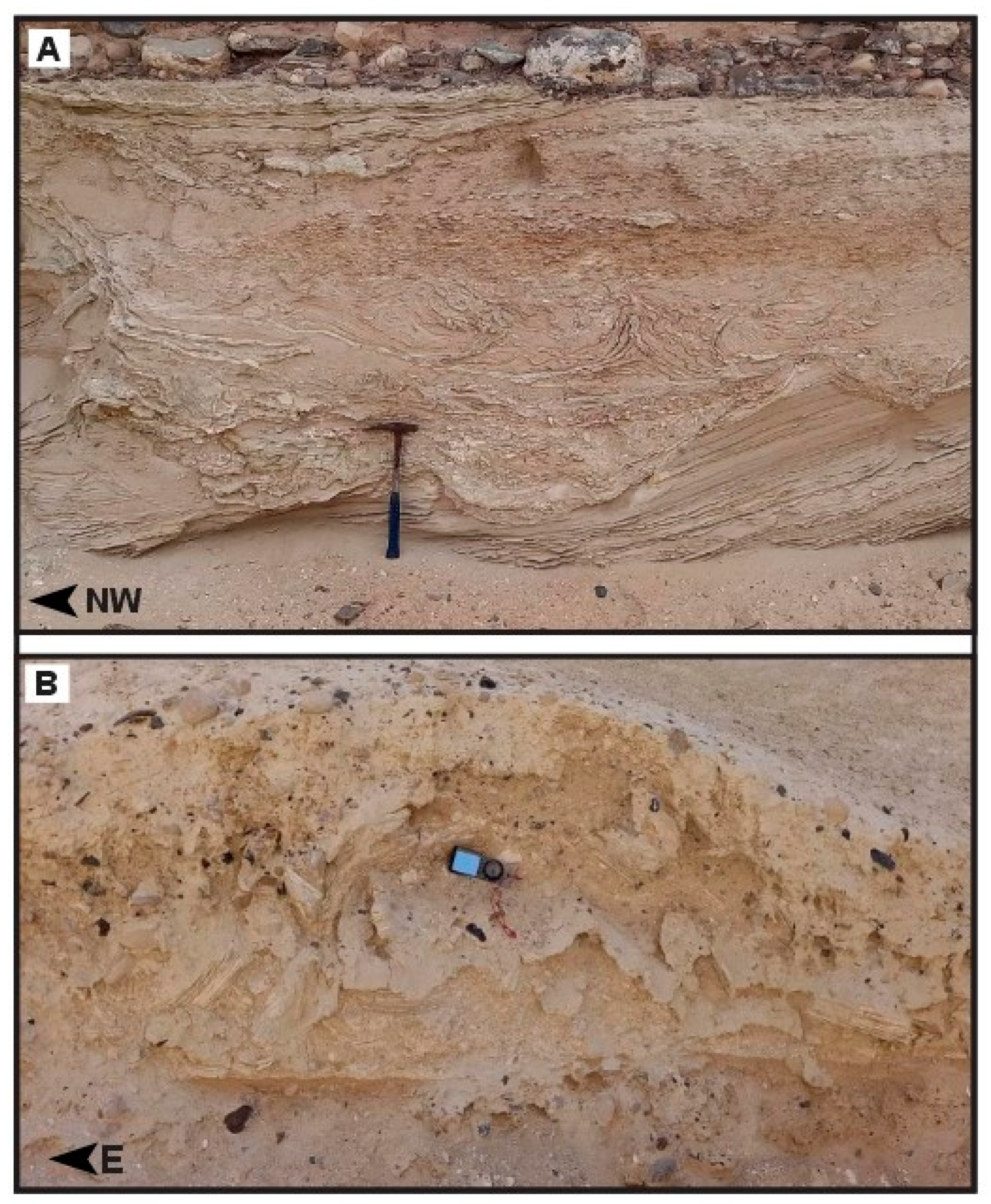
4.1.3. Cross-Cutting Injection Dikes and Neptunian Dykes
4.1.4. Load and Flame Structures
4.1.5. Fragile Clast
4.2. Mineralogical Analysis
4.3. Geochemical Analysis
5. Discussion
5.1. Sedimentological and Lithological Settings of the SSDSs
5.2. Seismically Induced Soft Sediment Deformations (SSDSs)
6. Conclusions
Author Contributions
Funding
Data Availability Statement
Acknowledgments
Conflicts of Interest
References
- Seilacher, A. Fault-graded beds interpreted as seismites. Sedimentology 1969, 13, 155–159. [Google Scholar] [CrossRef]
- Plaziat, J.; Ahmamou, M. Les Différents Mécanismes à l’Origine de La Diversité Des Séismites, Leur Identification Dans Le Pliocène Du Saïss de Fès et de Meknès (Maroc) et Leur Signification Tectonique. Geodin. Acta 1998, 11, 183–203. [Google Scholar] [CrossRef]
- Montenat, C.; Barrier, P.; Ott d′Estevou, P.; Hibsch, C. Seismites: An Attempt at Critical Analysis and Classification. Sediment. Geol. 2007, 196, 5–30. [Google Scholar] [CrossRef]
- Owen, G.; Moretti, M. Determining the Origin of Soft-Sediment Deformation Structures: A Case Study from Upper Carboniferous Delta Deposits in South-West Wales, UK. Terra Nova 2008, 20, 237–245. [Google Scholar] [CrossRef]
- Owen, G.; Moretti, M.; Alfaro, P. Recognising Triggers for Soft-Sediment Deformation: Current Understanding and Future Directions. Sediment. Geol. 2011, 235, 133–140. [Google Scholar] [CrossRef]
- Ezquerro, L.; Moretti, M.; Liesa, C.L.; Luzón, A.; Múñoz, L. Seismites from a Well Core of Palustrine Deposits as a Tool for Reconstructing the Palaeoseismic History of a Fault. Tectonophysics 2015, 655, 191–205. [Google Scholar] [CrossRef]
- El-Isa, Z.H.; Mustafa, H. Earthquake Deformations in the Lisan Deposits and Seismotectonic Implications. Geophys. J. Int. 1986, 86, 413–424. [Google Scholar] [CrossRef]
- Rossetti, D.D.F. Soft-Sediment Deformation Structures in Late Albian to Cenomanian Deposits, Sao Luis Basin, Northern Brazil: Evidence for Palaeoseismicity. Sedimentology 1999, 46, 1065–1081. [Google Scholar] [CrossRef]
- Van Loon, A.J. Soft-Sediment Deformation Structures in Siliciclastic Sediments: An Overview. Geologos 2009, 15, 3–55. [Google Scholar]
- Moretti, M.; Alfaro, P.; Owen, G. The Environmental Significance of Soft-Sediment Deformation Structures: Key Signatures for Sedimentary and Tectonic Processes. Sediment. Geol. 2016, 344, 1–4. [Google Scholar] [CrossRef]
- Amaireh, M. Overpressure and Liquefaction in the Recent Deposition of the Dead Sea and Resulting Features. Master’s Thesis, The University of Jordan, Amman, Jordan, 2017. Unpublished. [Google Scholar]
- Allen, J.R.L. The Plan Shape of Current Ripples in Relation to Flow Conditions. Sedimentology 1977, 24, 53–62. [Google Scholar] [CrossRef]
- Allen, J.R.L. Sedimentary Structures: Their Character and Physical Basis; Elsevier Scientific Pub. Co.: New York, NY, USA, 1982; ISBN 9780444419354. [Google Scholar]
- Owen, G. Deformation Processes in Unconsolidated Sands. Geol. Soc. Lond. Spec. Publ. 1987, 29, 11–24. [Google Scholar] [CrossRef]
- Agnon, A.; Migowski, C.; Marco, S. Intraclast Breccia Layers in Laminated Sequences: Recorders of Paleo-Earthquakes. Geol. Soc. Am. Spec. Publ. 2006, 401, 195–214. [Google Scholar] [CrossRef]
- Greb, S.F.; Archer, A.W. Soft-Sediment Deformation Produced by Tides in a Meizoseismic Area, Turnagain Arm, Alaska. Geology 2007, 35, 435. [Google Scholar] [CrossRef]
- Moretti, M.; van Loon, A.T.; Liu, M.; Wang, Y. Restrictions to the Application of “Diagnostic” Criteria for Recognizing Ancient Seismites. J. Palaeogeogr. 2014, 3, 162–173. [Google Scholar] [CrossRef]
- Feng, Z.Z.; Bao, Z.D.; Zheng, X.J.; Wang, Y. Researches of Soft-Sediment Deformation Structures and Seismites in China—A brief Review. J. Palaeogeogr. 2016, 5, 311–317. [Google Scholar] [CrossRef]
- Hibsch, C.; Alvarado, A.; Yepes, H.; Perez, V.H.; Sébrier, M. Holocene liquefaction and soft-sediment deformation in Quito (Ecuador): A paleoseismic history recorded in lacustrine sediments. J. Geodyn. 1997, 24, 259–280. [Google Scholar] [CrossRef]
- Mohindra, R.; Bagati, T.N. Seismically induced soft-sediment deformation structures (seismites) around Sumdo in the lower Spiti valley (Tethys Himalaya). Sediment. Geol. 1996, 101, 69–83. [Google Scholar] [CrossRef]
- Seilacher, A. Sedimentary Structures Tentatively Attributed to Seismic Events. Mar. Geol. 1984, 55, 1–12. [Google Scholar] [CrossRef]
- Lowe, D.R. Water Escape Structures in Coarse-Grained Sediments. Sedimentology 1975, 22, 157–204. [Google Scholar] [CrossRef]
- Seth, A.; Sarkar, S.; Bose, P.K. Synsedimentary Seismic Activity in an Immature Passive Margin Basin (Lower Member of the Katrol Formation, Upper Jurassic, Kutch, India). Sediment. Geol. 1990, 68, 279–291. [Google Scholar] [CrossRef]
- Pratt, B.R. Seismites in the Mesoproterozoic Altyn Formation (Belt Supergroup), Montana: A Test for Tectonic Control of Peritidal Carbonate Cyclicity. Geology 1994, 22, 1091. [Google Scholar] [CrossRef]
- Van Loon, A.J.; Pisarska-Jamroży, M. Sedimentological Evidence of Pleistocene Earthquakes in NW Poland Induced by Glacio-Isostatic Rebound. Sediment. Geol. 2014, 300, 1–10. [Google Scholar] [CrossRef]
- Enzel, Y.; Amit, R.; Dayan, U.; Crouvi, O.; Kahana, R.; Ziv, B.; Sharon, D. The Climatic and Physiographic Controls of the Eastern Mediterranean over the Late Pleistocene Climates in the Southern Levant and Its Neighboring Deserts. Glob. Planet. Change 2008, 60, 165–192. [Google Scholar] [CrossRef]
- Torfstein, A.; Enzel, Y. Dead Sea lake level changes and Levant palaeoclimate. In Quaternary of the Levant: Environments, Climate Change, and Humans; Cambridge University Press: Cambridge, UK, 2017; pp. 115–126. [Google Scholar]
- Garfunkel, Z. Internal Structure of the Dead Sea Leaky Transform (Rift) in Relation to Plate Kinematics. Tectonophysics 1981, 80, 81–108. [Google Scholar] [CrossRef]
- Donahue, J. The Dead Sea: The Lake and Its Setting. By Tina M. Niemi, Zvi Ben-Avraham, and Joel R. Gat. Am. J. Archaeol. 1999, 103, 3. [Google Scholar] [CrossRef]
- Ben Dor, Y.; Neugebauer, I.; Enzel, Y.; Schwab, M.H.; Tjallingii, R.; Erel, Y.; Brauer, A. Varves of the Dead Sea Sedimentary Record. Quat. Sci. Rev. 2019, 1, 173–184. [Google Scholar] [CrossRef]
- Atallah, M. Tectonic evolution of northern Wadi Araba, Jordan. Tectonophysics 1992, 204, 17–26. [Google Scholar] [CrossRef]
- Al Hseinat, M.; Al-Rawabdeh, A.; Al-Zidaneen, M.; Ghanem, H.; Al-Taj, M.; Diabat, A.; Jarrar, G.; Atallah, M. New Insights for Understanding the Structural Deformation Style of the Strike-Slip Regime along with the Wadi Shueib and Amman-Hallabat Structures in Jordan Based on Remote Sensing Data Analysis. Geosciences 2020, 10, 253. [Google Scholar] [CrossRef]
- Stern, R.J.; Johnson, P. Continental Lithosphere of the Arabian Plate; a Geologic, Petrologic, and Geophysical Synthesis. Earth-Sci. Rev. 2010, 101, 29–67. [Google Scholar] [CrossRef]
- Quennell, A.M. The Geology and Mineral Resources of (Former) Trans-Jordan; HM Stationery Office: England, UK, 1951. [Google Scholar]
- Garfunkel, Z.; Zak, Y.; Freund, R. Active faulting in the Dead Sea rift. Tectonophysics 1981, 80, 1–26. [Google Scholar] [CrossRef]
- Hempton, M. Constraints on Arabian plate motion and extensional history of the Red Sea. Tectonics 1987, 6, 687–705. [Google Scholar] [CrossRef]
- Lu, Y.; Bookman, R.; Waldmann, N.; Marco, S. A 45 kyr laminae record from the Dead Sea: Implications for basin erosion and floods recurrence. Quat. Sci. Rev. 2020, 229, 106143. [Google Scholar] [CrossRef]
- Quennell, A.M. The structural and geomorphic evolution of the Dead Sea Rift. Q. J. Geol. Soc. 1958, 114, 1–24. [Google Scholar] [CrossRef]
- Freund, R.; Garfunkel, Z.; Zak, I.; Goldberg, M.; Weissbrod, T.; Derin, B.; Girdler, R.W. The shear along the Dead Sea rift. Philos. Trans. R. Soc. London. Ser. A Math. Phys. Sci. 1970, 267, 107–130. [Google Scholar]
- Letouzey, J.; Tremolieres, P. Paleo-stress fields around the Mediterranean since the Mesozoic from microtectonics. Comparison with plate tectonic data. In Tectonic Stresses in the Alpine-Mediterranean Region: Proceedings of the Symposium Held in Vienna, Austria, 13–14 September 1979; Springer: Vienna, Austria, 1980; pp. 173–192. [Google Scholar]
- Segev, A.; Lyakhovsky, V.; Weinberger, R. Continental Transform–Rift Interaction Adjacent to a Continental Margin: The LevantCase Study. Earth-Sci. Rev. 2014, 139, 83–103. [Google Scholar] [CrossRef]
- Schattner, U.; Ben-Avraham, Z.; Reshef, M.; Bar-Am, G.; Lazar, M. Oligocene–Miocene Formation of the Haifa Basin: Qishon–Sirhan Rifting Coeval with the Red Sea–Suez Rift System. Tectonophysics 2006, 419, 1–12. [Google Scholar] [CrossRef]
- Hofmann, C.; Courtillot, V.; Féraud, G.; Rochette, P.; Yirgu, G.; Ketefo, E.; Pik, R. Timing of the Ethiopian Flood Basalt Event and Implications for Plume Birth and Global Change. Nature 1997, 389, 838–841. [Google Scholar] [CrossRef]
- Shimon Ilani, S.; Yehudit Harlavan, Y.; Khalid Tarawneh, K.; Rabba, I.; Weinberger, R.; Ibrahim, K.; Peltz, S.; Steinitz, G. New K- 591 Ar Ages of Basalts from the Harrat Ash Shaam Volcanic Field in Jordan: Implications for the Span and Duration of the Upper- Mantle Upwelling beneath the Western Arabian Plate. Geology 2001, 29, 171. [Google Scholar] [CrossRef]
- Pik, R.; Marty, B.; Carignan, J.; Lavé, J. Stability of the Upper Nile Drainage Network (Ethiopia) Deduced from (U–Th)/He Thermochronometry: Implications for Uplift and Erosion of the Afar Plume Dome. Earth Planet. Sci. Lett. 2003, 215, 73–88. [Google Scholar] [CrossRef]
- Segev, A.; Rybakov, M. History of Faulting and Magmatism in the Galilee (Israel) and across the Levant Continental Margin Inferred from Potential Field Data. J. Geodyn. 2011, 51, 264–284. [Google Scholar] [CrossRef]
- Avni, Y.; Segev, A.; Ginat, H. Oligocene Regional Denudation of the Northern Afar Dome: Pre- and Syn-Breakup Stages of the Afro-Arabian Plate. Geol. Soc. Am. Bull. 2012, 124, 1871–1897. [Google Scholar] [CrossRef]
- Faccenna, C.; Becker, T.W.; Jolivet, L.; Keskin, M. Mantle Convection in the Middle East: Reconciling Afar Upwelling, Arabia Indentation and Aegean Trench Rollback. Earth Planet. Sci. Lett. 2013, 375, 254–269. [Google Scholar] [CrossRef]
- Wald, R.; Schattner, U. Initiation of Arabian Plate Exposure during the Oligocene, Evidence from the Galilee, Israel. In Proceedings of the International Conference & Exhibition, Istanbul, Turkey, 17 September 2014. [Google Scholar]
- Bartov, Y.; Stein, M.; Enzel, Y.; Agnon, A.; Reches, Z. Lake Levels and Sequence Stratigraphy of Lake Lisan, the Late Pleistocene Precursor of the Dead Sea. Quat. Res. 2002, 57, 9–21. [Google Scholar] [CrossRef]
- Al-Saqarat, B.S.; Abbas, M.; Lai, Z.; Gong, S.; Alkuisi, M.M.; Abu Hamad, A.M.B.; Carling, P.A.; Jansen, J.D. A Wetland Oasis at Wadi Gharandal Spanning 125–70 Ka on the Human Migration Trail in Southern Jordan. Quat. Res. 2020, 100, 154–169. [Google Scholar] [CrossRef]
- Abbas, M.; Lai, Z.; Jansen, J.D.; Tu, H.; Alqudah, M.; Xu, X.; Al-Saqarat, B.S.; Mu’ayyad Al Hseinat; Ou, X.; Petraglia, M.D.; et al. Human Dispersals out of Africa via the Levant. Sci. Adv. 2023, 9, eadi6838. [Google Scholar] [CrossRef]
- Waldmann, N.; Stein, M.; Ariztegui, D.; Starinsky, A. Stratigraphy, Depositional Environments and Level Reconstruction of the Last Interglacial Lake Samra in the DSB. Quat. Res. 2009, 72, 1–15. [Google Scholar] [CrossRef]
- Torfstein, A.; Goldstein, S.L.; Kagan, E.J.; Stein, M. Integrated Multi-Site U–Th Chronology of the Last Glacial Lake Lisan. Geochim. Et Cosmochim. Acta 2013, 104, 210–231. [Google Scholar] [CrossRef]
- Landmann, G.; Abu Qudaira, G.M.; Shawabkeh, K.; Wrede, V.; Kempe, S. Geochemistry of the Lisan and Damya Formations in Jordan, and Implications for Palaeoclimate. Quat. Int. 2002, 89, 45–57. [Google Scholar] [CrossRef]
- Haase-Schramm, A.; Goldstein, S.L.; Stein, M. U-Th Dating of Lake Lisan (Late Pleistocene Dead Sea) Aragonite and Implications for Glacial East Mediterranean Climate Change. Geochim. Cosmochim. Acta 2004, 68, 985–1005. [Google Scholar] [CrossRef]
- Abed, A.M.; Yaghan, R. On the paleoclimate of Jordan during the last glacial maximum. Palaeogeogr. Palaeoclimatol. Palaeoecol. 2000, 160, 23–33. [Google Scholar] [CrossRef]
- Migowski, C.; Stein, M.; Prasad, S.; Negendank, J.F.W.; Agnon, A. Holocene Climate Variability and Cultural Evolution in the 550 near East from the Dead Sea Sedimentary Record. Quat. Res. 2006, 66, 421–431. [Google Scholar] [CrossRef]
- Kiro, Y.; Goldstein, S.L.; Lazar, B.; and Stein, M. Environmental implications of salt facies in the Dead Sea. Bulletin 2016, 128, 5–6, 824–841. [Google Scholar] [CrossRef]
- Alsop, G.I.; Weinberger, R.; Marco, S.; Levi, T. Folding during soft-sediment deformation. Geol. Soc. Lond. Spec. Publ. 2020, 487, 81–104. [Google Scholar] [CrossRef]
- Heifetz, E.; Agnon, A.; Marco, S. Soft Sediment Deformation by Kelvin Helmholtz Instability: A Case from Dead Sea Earthquakes. Earth Planet. Sci. Lett. 2005, 236, 497–504. [Google Scholar] [CrossRef]
- Drazin, P.G.; Reid, W.H. Darlene Reid Hydrodynamic Stability; Cambridge University Press: Cambridge, UK, 2004. [Google Scholar] [CrossRef]
- Marco, S.; Stein, M.; Agnon, A.; Ron, H. Long-Term Earthquake Clustering: A 50,000-Year Paleoseismic Record in the Dead Sea Graben. J. Geophys. Res. Solid Earth 1996, 101, 6179–6191. [Google Scholar] [CrossRef]
- Lowe, D.R.; LoPiccolo, R.D. The Characteristics and Origins of Dish and Pillar Structures. J. Sediment. Res. 1974, 44, 484–501. [Google Scholar] [CrossRef]
- LOWE, D.R. Subaqueous Liquefied and Fluidized Sediment Flows and Their Deposits. Sedimentology 1976, 23, 285–308. [Google Scholar] [CrossRef]
- Cosgrove, J.W. The Expression of Hydraulic Fracturing in Rocks and Sediments. Geol. Soc. Lond. Spec. Publ. 1995, 92, 187–196. [Google Scholar] [CrossRef]
- Levi, T.; Weinberger, R.; Aïfa, T.; Eyal, Y.; Marco, S. Injection Mechanism of Clay-Rich Sediments into Dikes during Earthquakes. Geochem. Geophys. Geosystems 2006, 7, 12. [Google Scholar] [CrossRef]
- Levi, T.; Weinberger, R.; Eyal, Y.; Lyakhovsky, V.; Heifetz, E. Velocities and Driving Pressures of Clay-Rich Sediments Injected into Clastic Dykes during Earthquakes. Geophys. J. Int. 2008, 175, 1095–1107. [Google Scholar] [CrossRef]
- Moretti, M.; Sabato, L. Recognition of Trigger Mechanisms for Soft-Sediment Deformation in the Pleistocene Lacustrine Deposits of the SantʻArcangelo Basin (Southern Italy): Seismic Shock vs. Overloading. Sediment. Geol. 2007, 196, 31–45. [Google Scholar] [CrossRef]
- Owen, G. Load Structures: Gravity-Driven Sediment Mobilization in the Shallow Subsurface. Geol. Soc. Lond. Spec. Publ. 2003, 216, 21–34. [Google Scholar] [CrossRef]
- Wang, P.; Zhang, B.; Qiu, W.-L.; Jian-cun, W. Soft-Sediment Deformation Structures from the Diexi Paleo-Dammed Lakes in the Upper Reaches of the Minjiang River, East Tibet. J. Asian Earth Sci. 2011, 40, 865–872. [Google Scholar] [CrossRef]
- Alsop, G.I.; Marco, S. Tsunami and Seiche-Triggered Deformation within Offshore Sediments. Sediment. Geol. 2012, 261–262, 90–107. [Google Scholar] [CrossRef]
- Prasad, S.; Vos, H.; Negendank, J.F.W.; Waldmann, N.; Goldstein, S.L.; Stein, M. Evidence from Lake Lisan of Solar Influence on Decadal- to Centennial-Scale Climate Variability during Marine Oxygen Isotope Stage 2. Geology 2004, 32, 581–584. [Google Scholar] [CrossRef]
- Prasad, S.; Negendank, J.F.W.; Stein, M. Varve Counting Reveals High Resolution Radiocarbon Reservoir Age Variations in Palaeolake Lisan. J. Quat. Sci. Publ. Quat. Res. Assoc. 2009, 24, 690–696. [Google Scholar] [CrossRef]
- Migowski, C.; Agnon, A.; Bookman, R.; Negendank, J.F.; Stein, M. Recurrence Pattern of Holocene Earthquakes along the Dead Sea Transform Revealed by Varve-Counting and Radiocarbon Dating of Lacustrine Sediments. Earth Planet. Sci. Lett. 2004, 222, 301–314. [Google Scholar] [CrossRef]
- Sims, J.D. Determining Earthquake Recurrence Intervals from Deformational Structures in Young Lacustrine Sediments. Tectonophysics 1975, 29, 141–152. [Google Scholar] [CrossRef]
- Scott, B.C.; Price, S.J. Earthquake-Induced Structures in Young Sediments. Tectonophysics 1988, 147, 165–170. [Google Scholar] [CrossRef]
- Maltman, A.J.; Bolton, A. How Sediments Become Mobilized. Geol. Soc. Lond. Spec. Publ. 2003, 216, 9–20. [Google Scholar] [CrossRef]
- Alvarez, W.; Staley, E.; O’Connor, D.; Chan, M.A. Synsedimentary Deformation in the Jurassic of Southeastern Utah—A Case of Impact Shaking? Geology 1998, 26, 579–582. [Google Scholar] [CrossRef]
- Alfaro, P.; Delgado, J.; Estévez, A.; Molina, J.M.; Moretti, M.; Soria, J.M. Liquefaction and Fluidization Structures in Messinian Storm Deposits (Bajo Segura Basin, Betic Cordillera, Southern Spain). Int. J. Earth Sci. 2002, 91, 505–513. [Google Scholar] [CrossRef]
- Weaver, L.; Arnaud, E. Polyphase Glacigenic Deformation in the Waterloo Moraine, Kitchener, Ontario, Canada. Sediment. Geol. 2011, 235, 292–303. [Google Scholar] [CrossRef]
- Arnaud, E. The Paleoclimatic Significance of Deformation Structures in Neoproterozoic Successions. Sediment. Geol. 2012, 243–244, 33–56. [Google Scholar] [CrossRef]
- Ravier, E.; Buoncristiani, J.-F.; Guiraud, M.; Menzies, J.; Clerc, S.; Goupy, B.; Portier, E. Porewater Pressure Control on Subglacial Soft Sediment Remobilization and Tunnel Valley Formation: A Case Study from the Alnif Tunnel Valley (Morocco). Sediment. Geol. 2014, 304, 71–95. [Google Scholar] [CrossRef]
- Wetzler, N.; Marco, S.; Heifetz, E. Quantitative analysis of seismogenic shear-induced turbulence in lake sediments. Geology 2010, 38, 303–306. [Google Scholar] [CrossRef]
- Li, J.; Jansen, J.; Carling, P.; Çiner, A.; Fan, X. Soft-sediment deformation structures within a 166 m-long drill core from Diexi Palaeolake, eastern Tibetan Plateau. Sediment. Geol. 2024; to be Submitted. [Google Scholar]
- Alsop, G.I.; Weinberger, R.; Marco, S.; Levi, T. Identifying Soft-Sediment Deformation in Rocks. J. Struct. Geol. 2019, 125, 248–255. [Google Scholar] [CrossRef]
- Qutishat, T. Active Tectonic Movement of the Dead Sea Transform Fault Induced Soft-Sediments Deformation: Instances from the Quaternary Deposits at Wadi Al-Alkharazeh. Master’s Thesis, The University of Jordan, Amman, Jordan, 2022; pp. 1–180. [Google Scholar]
- Al Hseinat, M.; AlZidaneen, M.; Jaradat, R.; Al-Rawabdeh, A.; Hübscher, C. Tectono-Stratigraphic Framework and Evolution of the Northwestern Arabian Plate, Central Jordan. Tectonophysics 2023, 863, 229993. [Google Scholar] [CrossRef]
- Abed, A.M. The Geology of Jordan and Its Environment and Water; Scientific Series 1; Publication of Association of Jordanian Geologists: Amman, Jordan, 2000; 571p. (In Arabic) [Google Scholar]
- Powell, J.H. The Geology of the Karak Area, Map Sheet No. 3152 III; Geology Directorate, Natural Resources Authority: Amman, Jordan, 1988; p. 171. [Google Scholar]
- Mart, Y.; Vachtman, D. The Internal Grabens of the Levant Rifts and Their Geodynamic Significance. Comptes Rendus Geoscience 2015, 347, 191–200. [Google Scholar] [CrossRef]
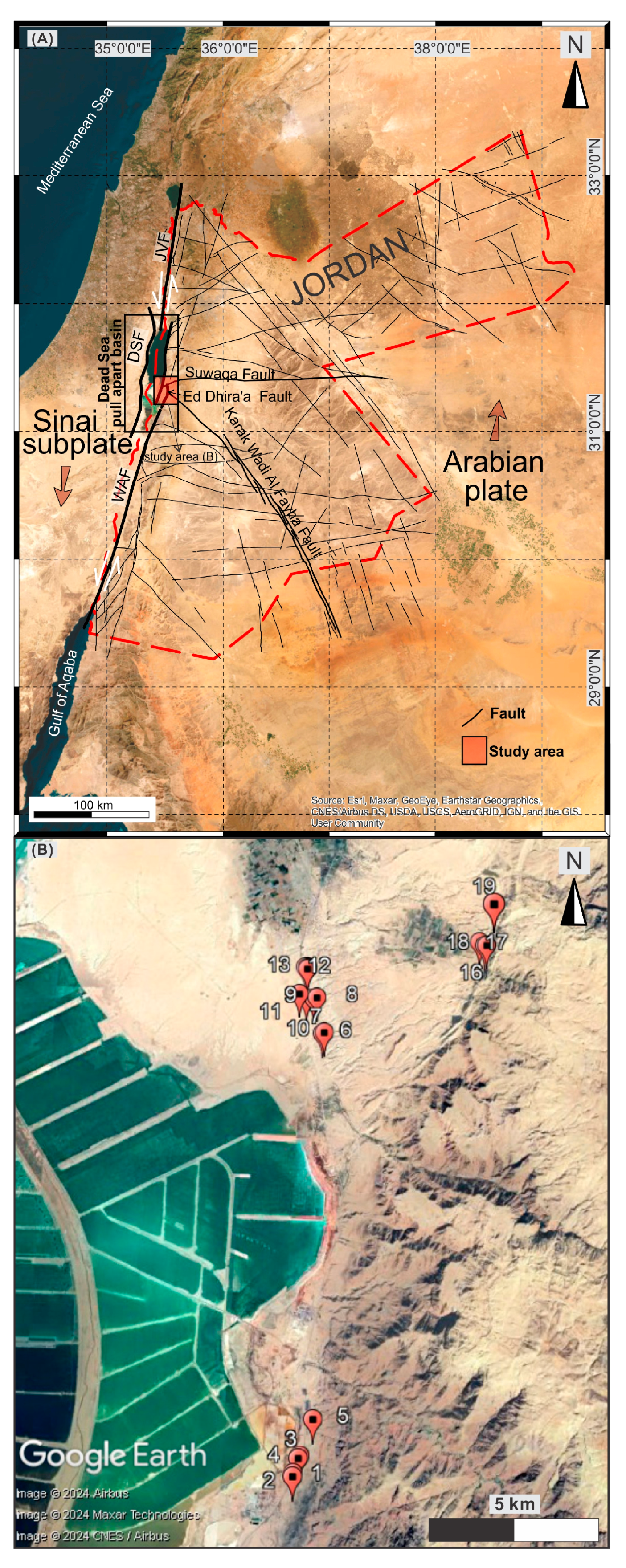
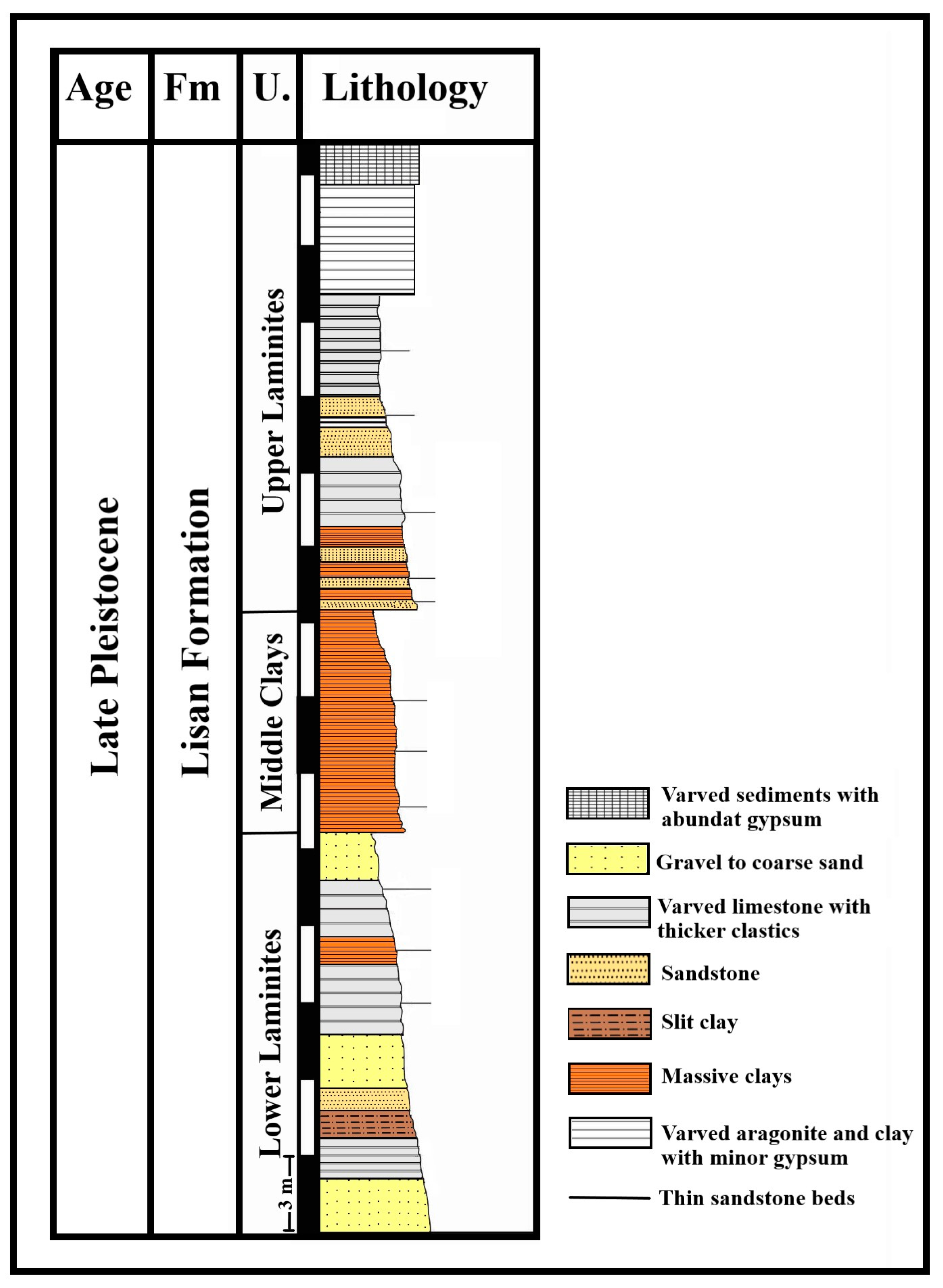
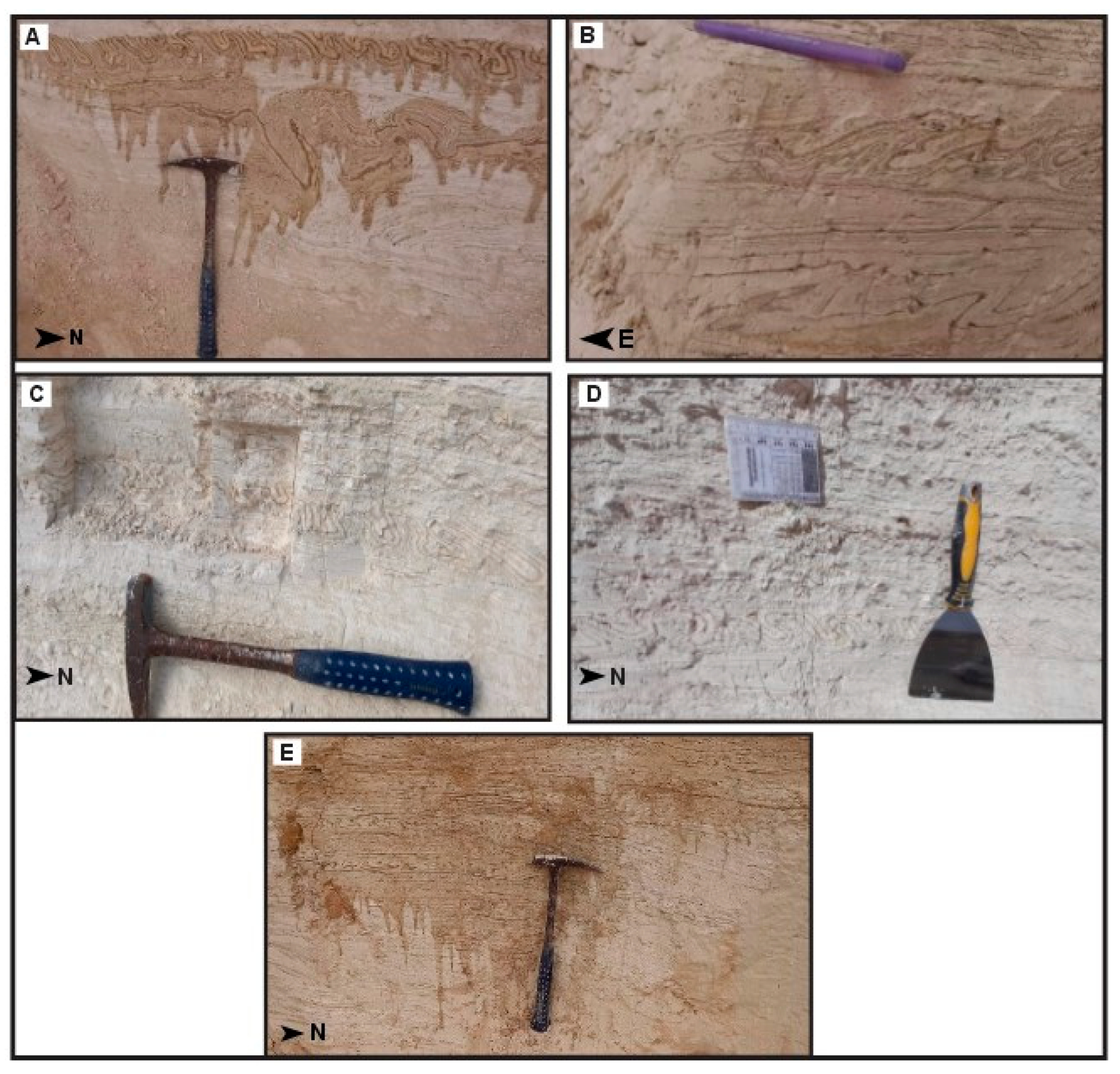
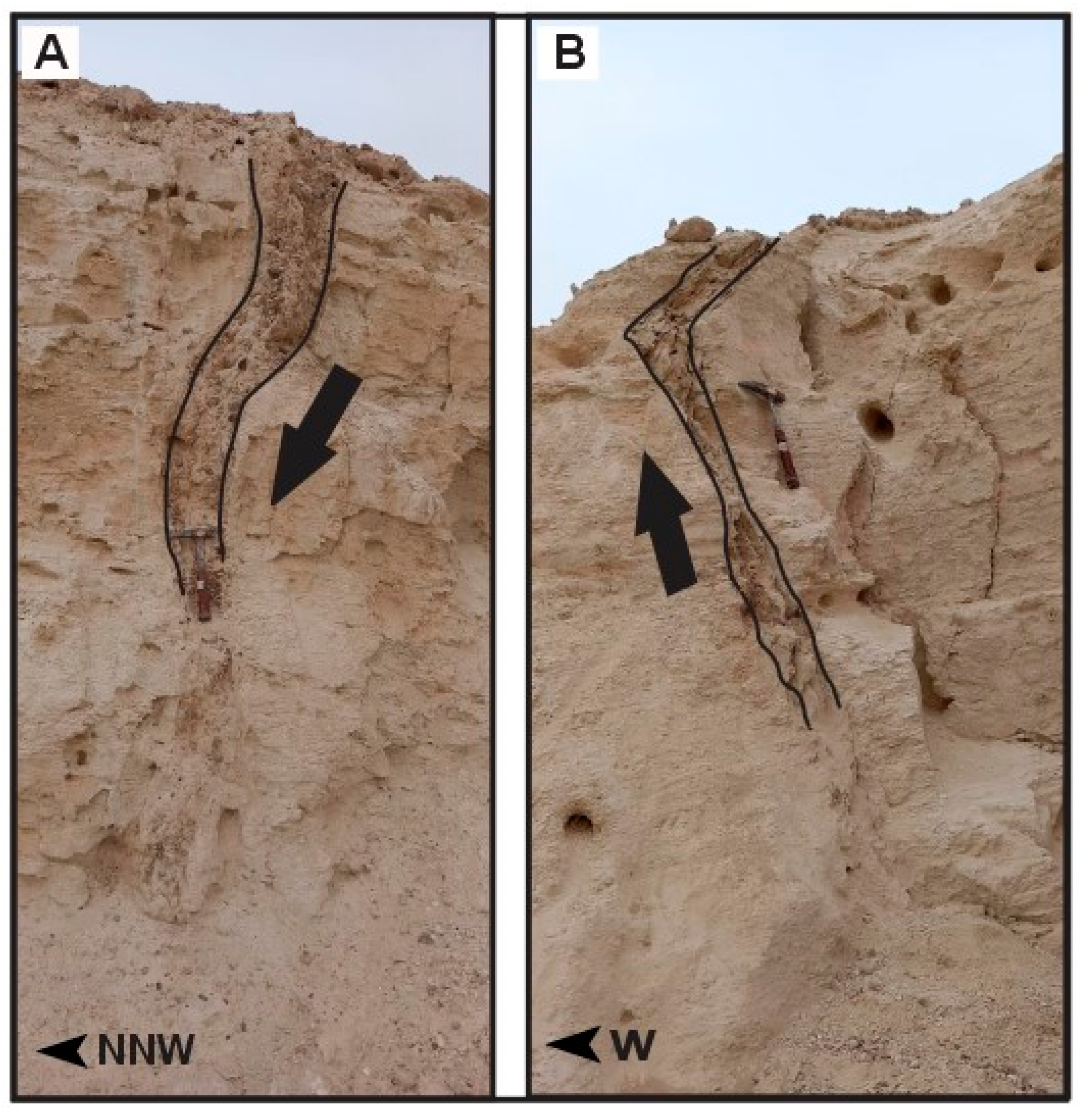
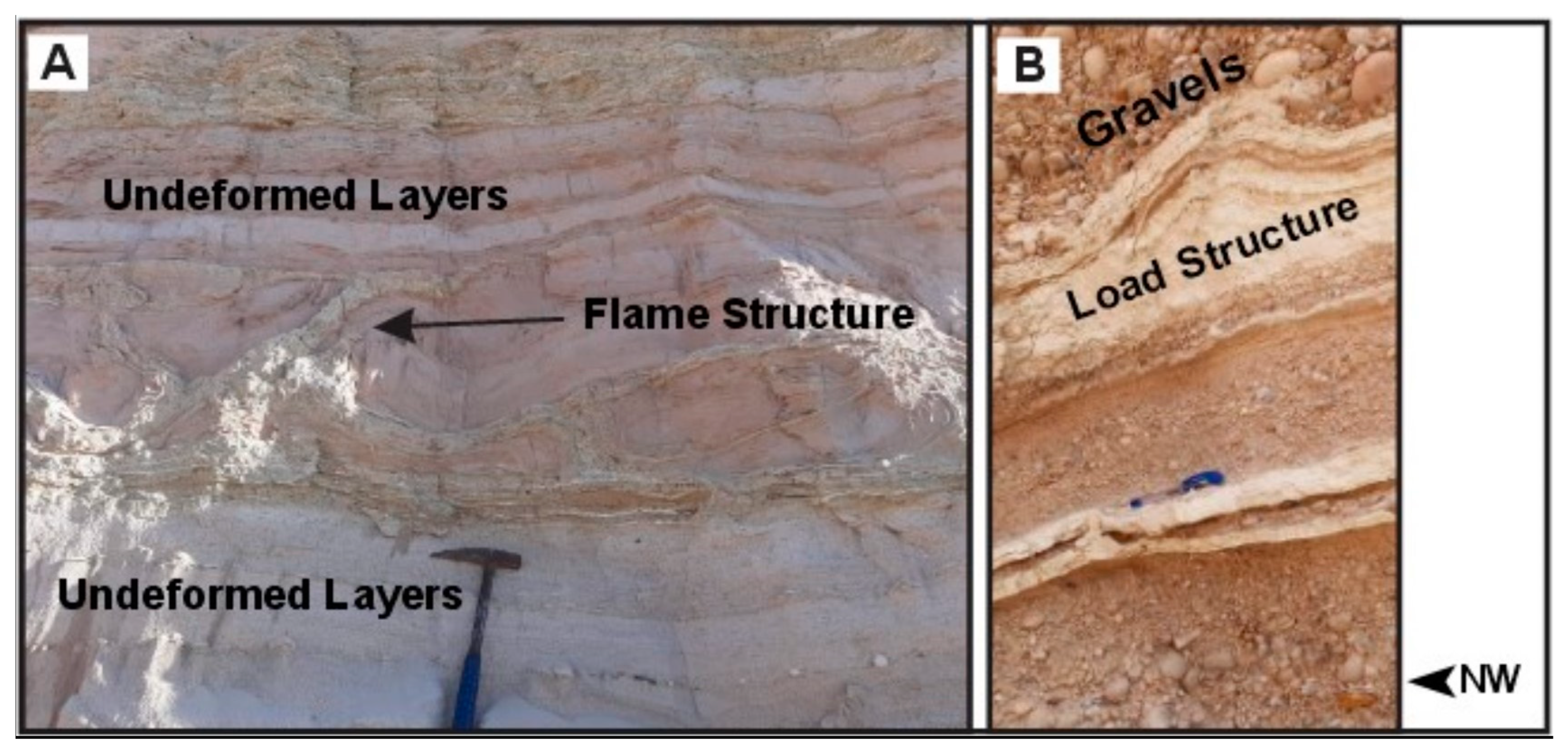
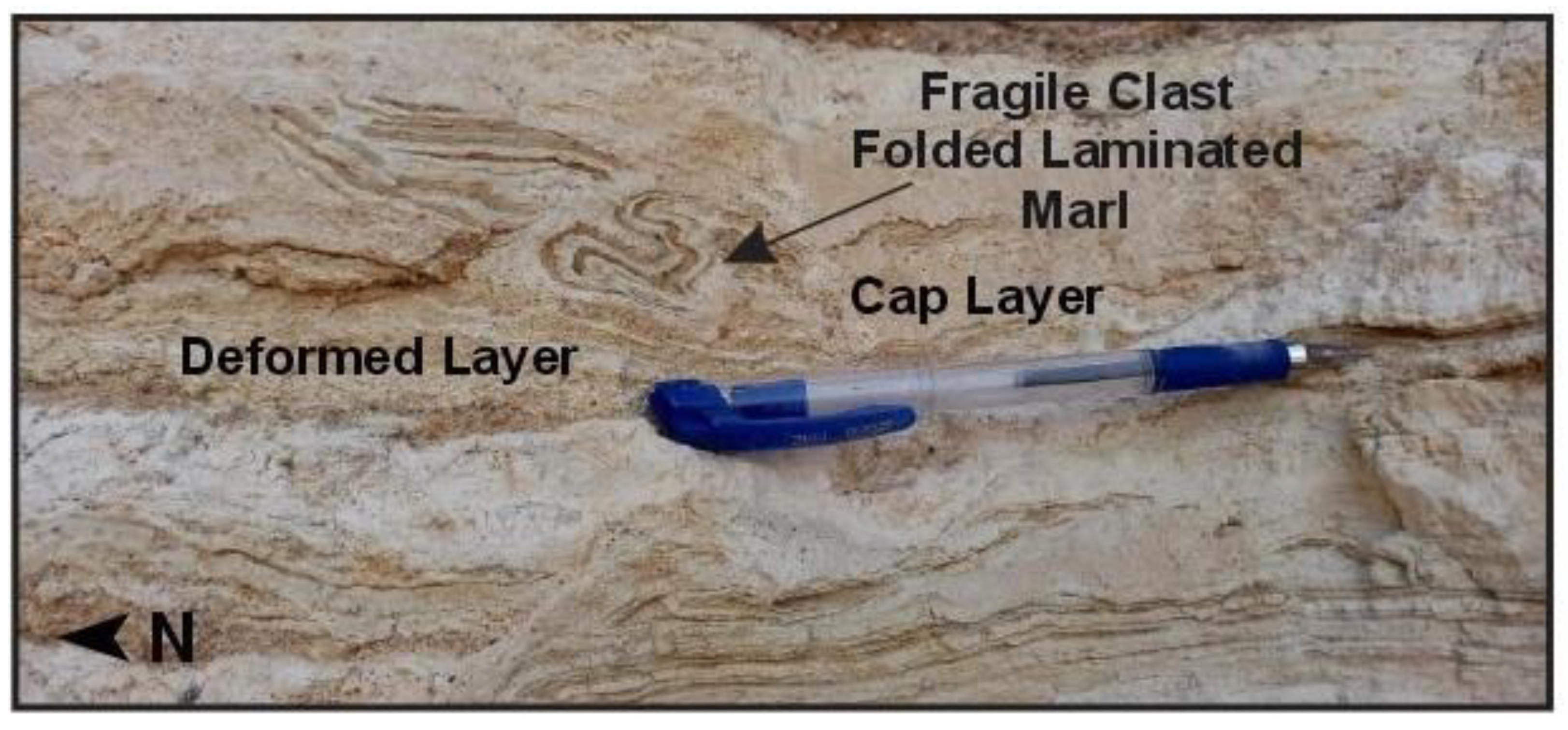



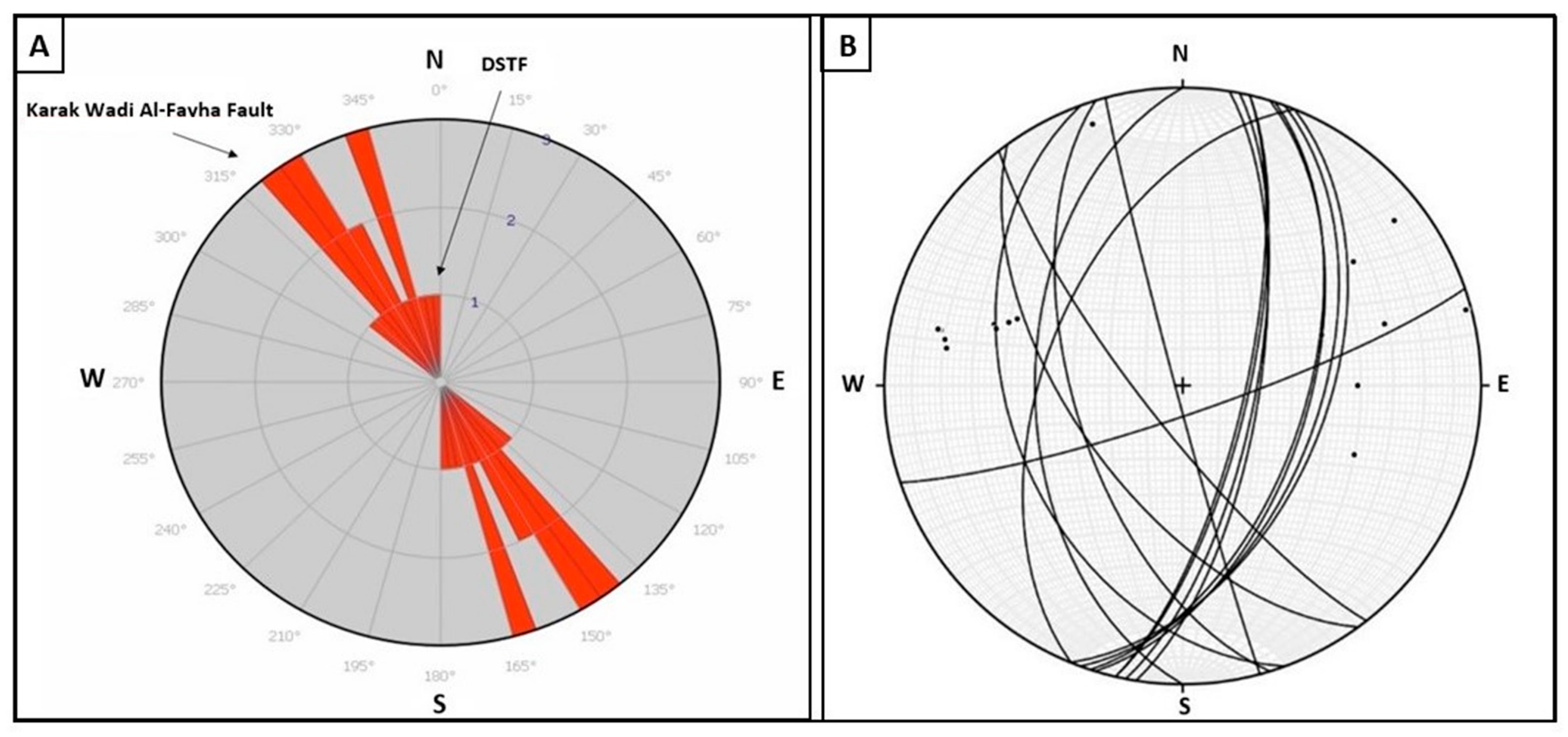
| Compound | Chemical Formula | Percentage (%) (Undeformed) | Percentage (%) (Deformed) |
|---|---|---|---|
| Calcium oxide | CaO | 46.37% | 44.27% |
| Quartz | SiO2 | 6.82% | 8.93% |
| Aluminum oxide | Al2O3 | 2.19% | 2.85% |
| Iron oxide | Fe2O3 | 1.49% | 1.92% |
| Magnesium oxide | MgO | 1.43% | 1.64% |
| Chlorine | Cl | 1.34% | 1.51% |
| Strontium oxide | SrO | 1.32% | 1.21% |
| Potassium oxide | K2O | 0.72% | 0.94% |
| Sulfur trioxide | SO3 | 0.71% | 0.77% |
| Sodium oxide | Na2O | 0.63% | 0.65% |
| Titanium dioxide | TiO2 | 0.2% | 0.30% |
| Phosphorus pentoxide | P2O5 | 0.10% | 0.10% |
| Manganese oxide | MnO | 0.02% | 0.03% |
| Chromium oxide | Cr2O3 | 0.02% | 0.02% |
| Copper oxide | CuO | 0.01% | 0.00% |
Disclaimer/Publisher’s Note: The statements, opinions and data contained in all publications are solely those of the individual author(s) and contributor(s) and not of MDPI and/or the editor(s). MDPI and/or the editor(s) disclaim responsibility for any injury to people or property resulting from any ideas, methods, instructions or products referred to in the content. |
© 2024 by the authors. Licensee MDPI, Basel, Switzerland. This article is an open access article distributed under the terms and conditions of the Creative Commons Attribution (CC BY) license (https://creativecommons.org/licenses/by/4.0/).
Share and Cite
Al-Saqarat, B.S.; Abbas, M.; Al Hseinat, M.; Qutishat, T.A.; Shammar, D.; AlShamaileh, E. Interpreting Soft-Sediment Deformation Structures: Insights into Earthquake History and Depositional Processes in the Dead Sea, Jordan. Geosciences 2024, 14, 217. https://doi.org/10.3390/geosciences14080217
Al-Saqarat BS, Abbas M, Al Hseinat M, Qutishat TA, Shammar D, AlShamaileh E. Interpreting Soft-Sediment Deformation Structures: Insights into Earthquake History and Depositional Processes in the Dead Sea, Jordan. Geosciences. 2024; 14(8):217. https://doi.org/10.3390/geosciences14080217
Chicago/Turabian StyleAl-Saqarat, Bety S., Mahmoud Abbas, Mu’ayyad Al Hseinat, Tala Amer Qutishat, Duha Shammar, and Ehab AlShamaileh. 2024. "Interpreting Soft-Sediment Deformation Structures: Insights into Earthquake History and Depositional Processes in the Dead Sea, Jordan" Geosciences 14, no. 8: 217. https://doi.org/10.3390/geosciences14080217







